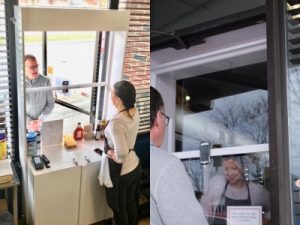Azrieli School grad designs shop window for pandemic times
Architecture in a time of coronavirus: “We needed to act as quickly as possible to get the shop open again”
 Josh Wallace (MArch ’19) has designed a window for his brother’s butcher shop to provide contact-less purchases during the pandemic.
Josh Wallace (MArch ’19) has designed a window for his brother’s butcher shop to provide contact-less purchases during the pandemic.
The “Window Stop” is a rolling service window for orders and pick-up. It was designed, built, and installed in April 2020 at the Around the Block Butcher Shop in Ottawa, owned by David Wallace.
Read the Ottawa Citizen article: https://bit.ly/35GTZ2I
“We wanted something that promised to increase safety but at the same time was practical to use and affordable,” says Josh Wallace. Below, he describes the rapid design-build process.
The need
Food stores are considered essential services in the time of the COVID-19 pandemic. They are allowed to remain open. There are many times that customers get closer to each other than two metres, the recommended safe distance for limiting spread. Around the Block Butcher Shop is a small but busy butcher store in the west end of Ottawa. At this time, we cannot welcome customers back into the small customer space of the butcher shop itself.
How the Window Stop works
The Window Stop is on wheels and rolls into place and latches securely onto the existing frame of the front door. It includes a rubber gasket that forms a reasonable seal on the door frame, reducing airflow between staff and customers. It has a large plexiglass window and uses a store cross-window intercom for two-way communication with customers.
After ordering, customers can pay using their credit or debit cards to tap through the plexiglass (from Canus Plastics in Ottawa). In the event they cannot tap, a blockade is removed from a point-of-sale machine-sized passage, and they can insert their card and enter their pin. The POS machine is then cleaned by staff. As well, the entire Window Stop is cleaned periodically.

Purchases are delivered through a “delivery box” below the plexiglass window. Customers only need to touch what they have purchased. This delivery box is sealed from the shop interior with cabinet doors that only staff can open. Before a staff member opens the inner cabinet door and passes a food order through, the customer must fully close the front door. Only when the food is in the box, and the staff-side inner cabinet door is fully sealed and latched can the customer open the front door and take their order.
The outer shop door handle has been modified so that customers can open it easily with their forearms and do not have to touch it with their hands. The design is inspired by an open-source handle developed by Materialize in Belgium for 3-D printing.
Customers are encouraged to practice physical distancing outside the shop, and markings on the sidewalk reinforce this.
The existing store architecture has not been altered to maintain original functionality in non-pandemic times.
Design thinking and process
My father Gordon (a medical doctor and patient safety expert) and I designed the Window Stop together. We had significant input from David, his partner Chantel, my mother Judy, and senior staff member Alex, all of whom have worked at length in the shop.

This input allowed for a bottom-up design process that harnessed each person’s experience and knowledge of the shop’s unique functions and customer relations, as well as food and process safety.
We wanted to find a balance between a high degree of safety while maintaining the personal touch and interactions for which the shop is known. This came to mean maximum transparency between customers and staff (as large a plexiglass panel as possible), without sacrificing safety.
We discussed keeping the front door closed and only opening it for the final food hand-off but decided that it was less safe and too impersonal.
We decided to make a welcoming “vestibule” with a touch-less intercom that connects customers to staff. This is important in a butcher shop, as many decisions are made by customers and staff discussing what’s available and how it should be prepared.
We all came up with the idea together over Skype while talking about how the pandemic was making the future of the business, like so many businesses, uncertain. After talking, my father quickly made a “sketch model” out of a Shreddies cereal box and old plastic food container.
This simple model then helped facilitate design discussions with the team. From there, we took down the dimensions of the door to make an as-found digital 3D model. The model allowed us to rapidly test various ideas while in dialogue with David, Judy, and Chantel, before cutting any materials, which saved costs. It also gave us visual materials to communicate our plans with customers over social media.
Once we all agreed on the design, my father and I built the Window Stop in 10 days inside the shop.
As we don’t have access to a woodshop and only small tools, we asked the staff at Home Depot to make the cuts for us on their panel saw. This meant we needed all dimensions to be figured out well in advance with a high degree of accuracy so the final build would fit snuggly and exactly onto the store’s existing door frame.
We asked the staff at Canus Plastics to cut the plexiglass, and they thankfully put our order on rush as it related to essential services during the virus. The precision of the digital model became especially helpful during this stage.
Challenges
Materials
Because global supply chains have slowed significantly, and we needed to act as quickly as possible to get the shop open again, we needed to source materials and products locally. We decided on using melamine-coated painted wood that could be cleaned easily. Other materials, such as copper surfaces (highly resistant to COVID-19), were too expensive.
Tools
We also had a limited set of tools, which meant that any long cuts usually done by a table saw became more complex, and added to the project’s delivery time.
Communication
Because the plexiglass window is sealed, it blocks sound and the ability to speak across it, unless you speak at a very high volume. Improving communication across the plexiglass window required experimentation. Intercoms such as used in drive-through setups by larger restaurant chains are very expensive. We settled on using an old iPhone mounted in the window that is on a continuous call with a staff member’s phone inside. Customers only need to speak and do not need to touch any phone controls. This smartphone approach works surprisingly well.
Cost
The total cost of this prototype is roughly $1,000 plus time and effort, which was, in this case, voluntary. If we were to do it again, we could likely bring down costs using the lessons learned from this build. We would be pleased to share our ideas and lessons learned with others considering similar approaches.
Customer comments
“Innovative and cool”
“Feels much safer”
“Was a stress-free pick-up experience”


